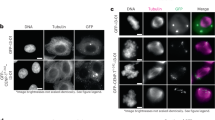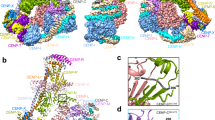Abstract
Accurate chromosome segregation depends on the kinetochore, which is the complex of proteins that link microtubules to centromeric DNA1. The kinetochore of the budding yeast Saccharomyces cerevisiae consists of more than 80 proteins assembled on a 125-bp region of DNA1. We studied the assembly and function of kinetochore components by fusing individual kinetochore proteins to the lactose repressor (LacI) and testing their ability to improve segregation of a plasmid carrying tandem repeats of the lactose operator (LacO). Targeting Ask1, a member of the Dam1–DASH microtubule-binding complex, creates a synthetic kinetochore that performs many functions of a natural kinetochore: it can replace an endogenous kinetochore on a chromosome, bi-orient sister kinetochores at metaphase during the mitotic cycle, segregate sister chromatids, and repair errors in chromosome attachment. We show the synthetic kinetochore functions do not depend on the DNA-binding components of the natural kinetochore but do require other kinetochore proteins. We conclude that tethering a single kinetochore protein to DNA triggers assembly of the complex structure that directs mitotic chromosome segregation.
This is a preview of subscription content, access via your institution
Access options
Subscribe to this journal
Receive 12 print issues and online access
$209.00 per year
only $17.42 per issue
Buy this article
- Purchase on Springer Link
- Instant access to full article PDF
Prices may be subject to local taxes which are calculated during checkout



Similar content being viewed by others
References
Tanaka, T. U. & Desai, A. Kinetochore-microtubule interactions: the means to the end. Curr. Opin. Cell Biol. 20, 53–63 (2008).
Haering, C. H., Farcas, A. M., Arumugam, P., Metson, J. & Nasmyth, K. The cohesin ring concatenates sister DNA molecules. Nature 454, 297–301 (2008).
Westermann, S., Drubin, D. G. & Barnes, G. Structures and functions of yeast kinetochore complexes. Annu. Rev. Biochem. 76, 563–591 (2007).
Murray, A. W. & Szostak, J. W. Pedigree analysis of plasmid segregation in yeast. Cell 34, 961–970 (1983).
Clarke, L. & Carbon, J. Isolation of a yeast centromere and construction of functional small circular chromosomes. Nature 287, 504–509 (1980).
Cheeseman, I. M. et al. Implication of a novel multiprotein Dam1p complex in outer kinetochore function. J. Cell Biol. 155, 1137–1145 (2001).
Li, Y. et al. The mitotic spindle is required for loading of the DASH complex onto the kinetochore. Genes Dev. 16, 183–197 (2002).
Janke, C., Ortiz, J., Tanaka, T. U., Lechner, J. & Schiebel, E. Four new subunits of the Dam1-Duo1 complex reveal novel functions in sister kinetochore biorientation. EMBO J. 21, 181–193 (2002).
Kiermaier, E., Woehrer, S., Peng, Y., Mechtler, K. & Westermann, S. A Dam1-based artificial kinetochore is sufficient to promote chromosome segregation in budding yeast. Nature Cell Biol. doi: 10.1038/ncb1924 (2009).
Haber, J. E. & Thorburn, P. C. Healing of broken linear dicentric chromosomes in yeast. Genetics 106, 207–226 (1984).
Hill, A. & Bloom, K. Genetic manipulation of centromere function. Mol. Cell Biol. 7, 2397–2405 (1987).
Joglekar, A. P., Salmon, E. D. & Bloom, K. S. Counting kinetochore protein numbers in budding yeast using genetically encoded fluorescent proteins. Methods Cell Biol. 85, 127–151 (2008).
Straight, A. F., Belmont, A. S., Robinett, C. C. & Murray, A. W. GFP tagging of budding yeast chromosomes reveals that protein-protein interactions can mediate sister chromatid cohesion. Curr. Biol. 6, 1599–1608 (1996).
Goshima, G. & Yanagida, M. Establishing biorientation occurs with precocious separation of the sister kinetochores, but not the arms, in the early spindle of budding yeast. Cell 100, 619–633 (2000).
He, X., Asthana, S. & Sorger, P. K. Transient sister chromatid separation and elastic deformation of chromosomes during mitosis in budding yeast. Cell 101, 763–775 (2000).
Tanaka, T., Fuchs, J., Loidl, J. & Nasmyth, K. Cohesin ensures bipolar attachment of microtubules to sister centromeres and resists their precocious separation. Nature Cell Biol. 2, 492–499 (2000).
Biggins, S. et al. The conserved protein kinase Ipl1 regulates microtubule binding to kinetochores in budding yeast. Genes Dev. 13, 532–544 (1999).
Biggins, S. & Murray, A. W. The budding yeast protein kinase Ipl1/Aurora allows the absence of tension to activate the spindle checkpoint. Genes Dev. 15, 3118–3129 (2001).
He, X., Rines, D. R., Espelin, C. W. & Sorger, P. K. Molecular analysis of kinetochore–microtubule attachment in budding yeast. Cell 106, 195–206 (2001).
Tanaka, T. U. et al. Evidence that the Ipl1–Sli15 (Aurora kinase-INCENP) complex promotes chromosome bi-orientation by altering kinetochore-spindle pole connections. Cell 108, 317–329 (2002).
Cheeseman, I. M., Chappie, J. S., Wilson-Kubalek, E. M. & Desai, A. The conserved KMN network constitutes the core microtubule-binding site of the kinetochore. Cell 127, 983–997 (2006).
Gaudet, A. & Fitzgerald-Hayes, M. Alterations in the adenine-plus-thymine-rich region of CEN3 affect centromere function in Saccharomyces cerevisiae. Mol. Cell Biol. 7, 68–75 (1987).
Yeh, E. et al. Pericentric chromatin is organized into an intramolecular loop in mitosis. Curr. Biol. 18, 81–90 (2008).
Westermann, S. et al. Formation of a dynamic kinetochore-microtubule interface through assembly of the Dam1 ring complex. Mol. Cell 17, 277–290 (2005).
Tanaka, K., Kitamura, E., Kitamura, Y. & Tanaka, T. U. Molecular mechanisms of microtubule-dependent kinetochore transport toward spindle poles. J. Cell Biol. 178, 269–281 (2007).
Li, Y. & Elledge, S. J. The DASH complex component Ask1 is a cell cycle-regulated Cdk substrate in Saccharomyces cerevisiae. Cell Cycle 2, 143–148 (2003).
Higuchi, T. & Uhlmann, F. Stabilization of microtubule dynamics at anaphase onset promotes chromosome segregation. Nature 433, 171–176 (2005).
Goh, P. Y. & Kilmartin, J. V. NDC10: a gene involved in chromosome segregation in Saccharomyces cerevisiae. J. Cell Biol. 121, 503–512 (1993).
Henikoff, S., Ahmad, K. & Malik, H. S. The centromere paradox: stable inheritance with rapidly evolving DNA. Science 293, 1098–1102 (2001).
Marshall, O. J., Chueh, A. C., Wong, L. H. & Choo, K. H. Neocentromeres: new insights into centromere structure, disease development, and karyotype evolution. Am. J. Hum. Genet. 82, 261–282 (2008).
Velmurugan, S., Yang, X. M., Chan, C. S., Dobson, M. & Jayaram, M. Partitioning of the 2-microm circle plasmid of Saccharomyces cerevisiae. Functional coordination with chromosome segregation and plasmid-encoded rep protein distribution. J. Cell Biol. 149, 553–566 (2000).
Hajra, S., Ghosh, S. K. & Jayaram, M. The centromere-specific histone variant Cse4p (CENP-A) is essential for functional chromatin architecture at the yeast 2-microm circle partitioning locus and promotes equal plasmid segregation. J. Cell Biol. 174, 779–790 (2006).
Sherman, F., Lawrence, C. W. & Fink, G. R. Methods in Yeast Genetics. (Cold Spring Harbor Laboratory Press,1979).
Longtine, M. S. et al. Additional modules for versatile and economical PCR-based gene deletion and modification in Saccharomyces cerevisiae. Yeast 14, 953–961 (1998).
Lang, G. I. & Murray, A. W. Estimating the per-base-pair mutation rate in the yeast Saccharomyces cerevisiae. Genetics 178, 67–82 (2008).
Foster, P. L. Methods for determining spontaneous mutation rates. Methods Enzymol. 409, 195–213 (2006).
Acknowledgements
We thank Greg Lang, Joana Gonçalves-Sá, John Koschwanez, Gregg Wildenberg and Dai Tsuchiya for technical advice; Charles Asbury, Ted Salmon, Steve Elledge, Ajit Joglekar, Frank Solomon, Amy Rowat and members of the Murray lab for critical reading of the manuscript; and Steve Elledge, John Kilmartin and Sue Biggins for strains. This work was supported by a US National Institutes of Health (NIH) National Research Service Award fellowship to S.L. and an NIH grant to A.W.M. (GM043987).
Author information
Authors and Affiliations
Contributions
S.L. and A.W.M. conceived and designed the experiments. S.L. and D.T.L. performed and analysed the experiments. S.L. and A.W.M. wrote the manuscript.
Corresponding author
Ethics declarations
Competing interests
The authors declare no competing financial interests.
Supplementary information
Supplementary Information
Supplementary Information (PDF 491 kb)
Rights and permissions
About this article
Cite this article
Lacefield, S., Lau, D. & Murray, A. Recruiting a microtubule-binding complex to DNA directs chromosome segregation in budding yeast. Nat Cell Biol 11, 1116–1120 (2009). https://doi.org/10.1038/ncb1925
Received:
Accepted:
Published:
Issue Date:
DOI: https://doi.org/10.1038/ncb1925
This article is cited by
-
Differentiating the roles of microtubule-associated proteins at meiotic kinetochores during chromosome segregation
Chromosoma (2016)
-
Regulatory mechanisms of kinetochore–microtubule interaction in mitosis
Cellular and Molecular Life Sciences (2013)
-
CENP-T proteins are conserved centromere receptors of the Ndc80 complex
Nature Cell Biology (2012)
-
Establishment of the vertebrate kinetochores
Chromosome Research (2012)
-
Reconstituting the kinetochore–microtubule interface: what, why, and how
Chromosoma (2012)



